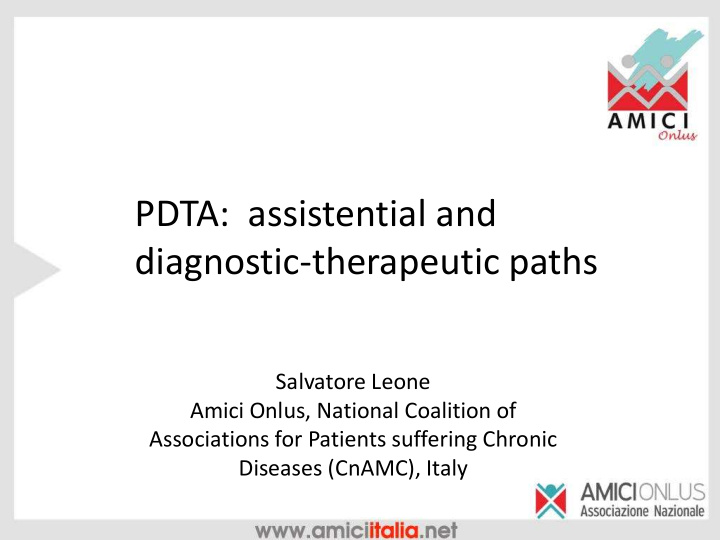



PDTA: assistential and diagnostic-therapeutic paths Salvatore Leone Amici Onlus, National Coalition of Associations for Patients suffering Chronic Diseases (CnAMC), Italy
What is IBD? Crohn’s disease and ulcerative colitis (collectively known as inflammatory bowel diseases or IBD) are chronic inflammatory, non-infectious conditions involving the digestive system. They should not be confused with IBS (irritable bowel syndrome), which, despite similar symptoms, is a separate condition. Ulcerative colitis is restricted to the colon and/or the rectum, whereas Crohn’s disease can affect any part of the gastrointestinal tract. Ulcerative colitis is twice as common as Crohn’s disease.
Symptoms Symptoms in both illnesses may include abdominal pain, diarrhoea, vomiting, rectal bleeding and weight loss. Both illnesses may be accompanied by various extraintestinal manifestations in e.g. the eyes and joints or on the skin. The intensity of the symptoms may vary a lot over time. Patients may experience long periods of remission and/or recurrent flare- ups.
Diagnosis Peak age for diagnosis in both conditions is between 10 and 40, but the disease can occur at any age. The diagnosis is usually based on an endoscopic examination of the bowel and biopsies of pathological lesions. Certain indicators of IBD, such as infection and anaemia, can also be determined in blood tests.
AMICI and EFCCA The European Federation of Crohn's & Ulcerative Colitis Associations is an umbrella organisation representing 29 national patients’ associations from 28 European countries and 3 associate members from outside Europe. www.efcca.org
GETTING A DIAGNOSIS • 13% of respondents say it took 1 – 2 years to get a diagnosis • Amongst the total sample, 14% had to wait 5 years or more for a diagnosis. IPACT (2010)
FREQUENCY OF HOSPITALISATION 81% of respondents have been hospitalised in the past 5 years, because of their IBD-related condition (34% for 1 – 5 days and 46% for longer than that). IMPACT 2010
Surgery • 16% have had one operation, 6% have had two operations, and 14% have had 3 or more. • It was noticeable that 5% of all respondents have had 5 or more operations. IMPACT 2010
Critical Issues Diagnostic delay Patient management that is not standardized throughout the national territory
COSTS Hospitalization of a resident in their own region in the south coast about 25% less than in the northern regions in mobility. Hospitalization of an IBD patients costs € 3,694 in Sicily (€ 4968 outside the region)
Abruzzo 3.210 Patients Exemption Basilicata 979 Calabria 3.620 Campania 10.033 Emilia Romagna 13.822 Friuli Venezia Giulia 3.654 Lazio 9.764 Liguria 4.835 Lombardia 26.452 Marche 3.150 Molise 658 Piemonte 19.206 Valle d'Aosta 334 Puglia 12.431 Sardegna 3.230 Agg. Marzo 2016 Sicilia 16.014 Toscana 12.303 Fonte: AMICI Onlus Trentino Alto Adige 2.811 www.amiciitalia.net Umbria 3.193 Veneto 12.275 ITALIA 161.974
Prevalence (100.000 ab.) Popolazione residente al 2011: 60.626.442 (Fonte ISTAT) 500 Agg. Marzo 2016 450 431 400 352 350 328 317 312 304 299 296 300 271 267 267 260 249 239 250 206 201 193 200 180 172 170 167 150 100 50 0 Abruzzo Basilicata Calabria Campania Emilia Romagna Friuli Venezia Giulia Lazio Liguria Lombardia Marche Molise Piemonte Valle d'Aosta Puglia Sardegna Sicilia Toscana Trentino Alto Adige Umbria Veneto ITALIA Fonte: AMICI Onlus - www.amiciitalia.net
Why a PDTA? Increased prevalence and the social cost of IBD These are complex and heterogeneous diseases We need a multidisciplinary approach We need to define levels of competence ("volumes" and experience) We need to promote adherence to national and international guidelines but also customizing the management of the disease
PDTA collective commitment Endoscopist Radiologist Rheumatologist Agenas Nurse Ministry of Health Psychologist Surgeon Gastroenterologist GP Pharmacist
PDTA is an opportunity to improve • reduce the costs generated by a late diagnosis, due to a more aggressive disease that requires more expensive therapies and treatments, and by the non-standardization of care that, in fact, pushes patients to move other regions in search of better care, with a significant increase in direct and indirect costs
PDTA a governance tool Respond to the health needs of the citizen Promote continuity of care, especially among hospital and territory Reduce the clinical variability Promote proper use of resources
PDTA and the European Charter of Patients’ rights 1. Right of access 2. Right to free choice 3. Right to innovation. 4. Right to personalized treatment
Via A. Wildt, 19/4 20131 Milano tel. 02 2893673 www.a mic iita lia .ne t Sa lvo .le o ne @ a mic iita lia .ne t
Recommend
More recommend